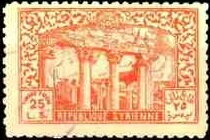Stamp: Great Colonnade, Palmyra (Syria 1940)
Great Colonnade, Palmyra (Syria 1940)
01 January (Syria ) within release Fiscal goes into circulation Stamp Great Colonnade, Palmyra face value 25 Syrian pound
| Stamp Great Colonnade, Palmyra in catalogues | |
|---|---|
| Colnect codes: | Col: SY F1940-18 |
Stamp is square format.
Revenue Reverend cat. no: R459Also in the issue Fiscal:
- Stamp - Umayyad Mosque, Damascus face value 50;
- Stamp - Umayyad Mosque, Damascus face value 35;
- Stamp - Umayyad Mosque, Damascus face value 35;
- Stamp - Great Colonnade, Palmyra face value 200;
- Stamp - Great Colonnade, Palmyra face value 250;
- Stamp - Great Colonnade, Palmyra face value 500;
- Stamp - Great Colonnade, Palmyra face value 25;
- Stamp - Aleppo Citadel face value 2;
- Stamp - Aleppo Citadel face value 5;
- Stamp - Aleppo Citadel face value 6;
- Stamp - Aleppo Citadel face value 15;
- Stamp - Aleppo Citadel face value 20;
- Stamp - Aleppo Citadel face value 30;
- Stamp - Aleppo Citadel face value 40;
- Stamp - Aleppo Citadel face value 150;
- Stamp - Aleppo Citadel face value 150;
|
Data entry completed
53%
|
|
|---|---|
| Stamp Great Colonnade, Palmyra in digits | |
| Country: | Syria |
| Date: | 1940-01-01 |
| Perforation: | 11 |
| Emission: | Revenue |
| Format: | Stamp |
| Face Value: | 25 Syrian pound |
Stamp Great Colonnade, Palmyra it reflects the thematic directions:
Architecture (Latin architectura, from the Greek ἀρχιτέκτων arkhitekton "architect", from ἀρχι- "chief" and τέκτων "builder") is both the process and the product of planning, designing, and constructing buildings and other physical structures. Architectural works, in the material form of buildings, are often perceived as cultural symbols and as works of art. Historical civilizations are often identified with their surviving architectural achievements.
A building or edifice is a structure with a roof and walls standing more or less permanently in one place, such as a house or factory. Buildings come in a variety of sizes, shapes and functions, and have been adapted throughout history for a wide number of factors, from building materials available, to weather conditions, to land prices, ground conditions, specific uses and aesthetic reasons. Buildings serve several needs of society – primarily as shelter from weather, security, living space, privacy, to store belongings, and to comfortably live and work. A building as a shelter represents a physical division of the human habitat (a place of comfort and safety) and the outside (a place that at times may be harsh and harmful).
A monument is a type of structure that was explicitly created to commemorate a person or event, or which has become relevant to a social group as a part of their remembrance of historic times or cultural heritage, due to its artistic, historical, political, technical or architectural importance. Examples of monuments include statues, (war) memorials, historical buildings, archaeological sites, and cultural assets. If there is a public interest in its preservation, a monument can for example be listed as a UNESCO World Heritage Site. The Palgrave Encyclopedia of Cultural Heritage and Conflict gives the next definition of monument:



